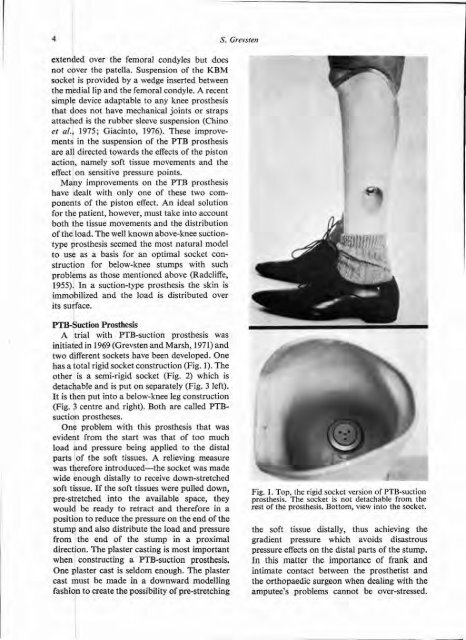Prosthetics and Orthotics
Prosthetics and Orthotics
Prosthetics and Orthotics
Create successful ePaper yourself
Turn your PDF publications into a flip-book with our unique Google optimized e-Paper software.
extended over the femoral condyles but does<br />
not cover the patella. Suspension of the KBM<br />
socket is provided by a wedge inserted between<br />
the medial lip <strong>and</strong> the femoral condyle. A recent<br />
simple device adaptable to any knee prosthesis<br />
that does not have mechanical joints or straps<br />
attached is the rubber sleeve suspension (Chino<br />
et al., 1975; Giacinto, 1976). These improvements<br />
in the suspension of the PTB prosthesis<br />
are all directed towards the effects of the piston<br />
action, namely soft tissue movements <strong>and</strong> the<br />
effect on sensitive pressure points.<br />
Many improvements on the PTB prosthesis<br />
have dealt with only one of these two components<br />
of the piston effect. An ideal solution<br />
for the patient, however, must take into account<br />
both the tissue movements <strong>and</strong> the distribution<br />
of the load. The well known above-knee suctiontype<br />
prosthesis seemed the most natural model<br />
to use as a basis for an optimal socket construction<br />
for below-knee stumps with such<br />
problems as those mentioned above (Radcliffe,<br />
1955). In a suction-type prosthesis the skin is<br />
immobilized <strong>and</strong> the load is distributed over<br />
its surface.<br />
PTB-Suction Prosthesis<br />
A trial with PTB-suction prosthesis was<br />
initiated in 1969 (Grevsten <strong>and</strong> Marsh, 1971) <strong>and</strong><br />
two different sockets have been developed. One<br />
has a total rigid socket construction (Fig. 1). The<br />
other is a semi-rigid socket (Fig. 2) which is<br />
detachable <strong>and</strong> is put on separately (Fig. 3 left).<br />
It is then put into a below-knee leg construction<br />
(Fig. 3 centre <strong>and</strong> right). Both are called PTBsuctiou<br />
prostheses.<br />
One problem with this prosthesis that was<br />
evident from the start was that of too much<br />
load <strong>and</strong> pressure being applied to the distal<br />
parts of the soft tissues. A relieving measure<br />
was therefore introduced—the socket was made<br />
wide enough distally to receive down-stretched<br />
soft tissue. If the soft tissues were pulled down,<br />
pre-stretched into the available space, they<br />
would be ready to retract <strong>and</strong> therefore in a<br />
position to reduce the pressure on the end of the<br />
stump <strong>and</strong> also distribute the load <strong>and</strong> pressure<br />
from the end of the stump in a proximal<br />
direction. The plaster casting is most important<br />
when constructing a PTB-suction prosthesis.<br />
One plaster cast is seldom enough. The plaster<br />
cast must be made in a downward modelling<br />
fashion to create the possibility of pre-stretching<br />
Fig. 1. Top, the rigid socket version of PTB-suction<br />
prosthesis. The socket is not detachable from the<br />
rest of the prosthesis. Bottom, view into the socket.<br />
the soft tissue distally, thus achieving the<br />
gradient pressure which avoids disastrous<br />
pressure effects on the distal parts of the stump.<br />
In this matter the importance of frank <strong>and</strong><br />
intimate contact between the prosthetist <strong>and</strong><br />
the orthopaedic surgeon when dealing with the<br />
amputee's problems cannot be over-stressed.

















